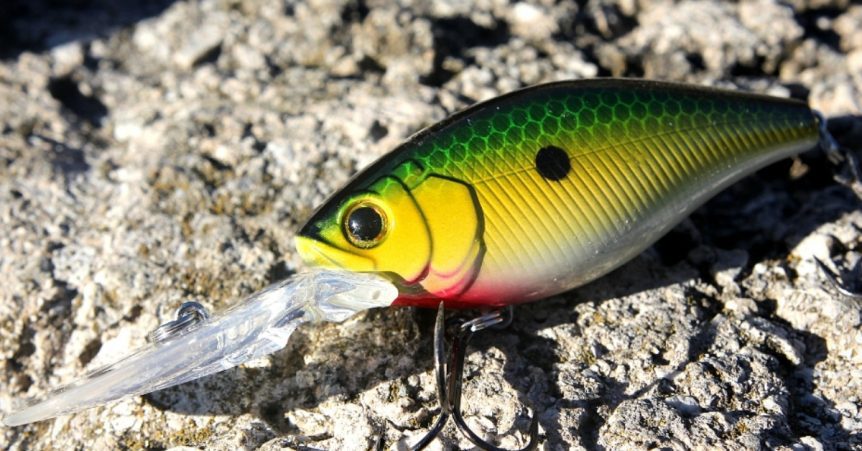Summer becomes vacation time for the novice angler, but for some serious bass anglers, it’s a time to go to work.
While many of us get away from work to enjoy the relaxing side of fishing, a handful of competitive anglers take an endurance test of deep cranking for summertime bass. This effective technique requires a few special angling skills, but it commands certain physical and mental attributes. You’ve got to be persistent because you might throw a crankbait for three hours and not get bit, then catch four in a row. A lot of anglers give up too early because they get worn out cranking after a couple of hours.
Search High And Low With Deep Divers

Deep cranking works best throughout the summer when bass are out on the deeper ridges off the flats and start feeding on the shad. While some lures work well early and late in the day during summer, deep-diving crankbaits provide round-the-clock action. You can start with it in the morning and use it all day long. A deep-diving crankbait is a really good search bait and a real good big fish bait. If you hit the right zone with it you can get well in a hurry on it.
Suns Out Cranks Out
The sun and moon phases have some influence on the best cranking periods so pay attention to whenever the major and minor feeding periods occur. Some lakes also have better deep-cranking action at certain times of the day. One lake might produce better in the late afternoon, while another lake might have a good crankbait bite in the morning but then shuts off the rest of the day.
A deep-diving crankbait is such an effective weapon in warmer water because of its ability to probe various depths. The crankbait allows you to cover a lot of water quickly to find either suspended bass or bass close to the bottom.
Go Deep Or Go Home
During most of the summer, bass in many lakes stay in the 15- to 20-foot range, which is reachable for most of today’s deep-diving crankbaits. Most deep divers will get down to 15 to 18 feet deep if you crank with 10-pound test line. If the fish are deeper than 15 feet dragging a Carolina rig or throwing a Texas-rigged plastic worm are more effective tactics for catching summertime bass.
Clear Water = Natural Colors
Dirty Water = Dark Colors
Water clarity determines which lure color to choose for deep-diving crankbaits. A color combination of blue back, bone sides and chartreuse belly or Tennessee shad are good choices for clear water. In dirtier water try blue and chartreuse or purple and chartreuse for your deep divers. If you keep missing strikes or if the fish are just hooked on the rear trebles, changing colors will cause bass to eat the crankbait better.
Deep-diving crankbaits can be worked effectively with a variety of retrieves. The whole key to using the lure is getting it down on the bottom. Vary the speed of your presentation by steadily reeling the lure until it hits bottom, then slowly grind it along the lake’s floor.
Stop And Go But Not Too Slow
You can experiment with your retrieve and then determine which speed the fish prefer. A medium to a fast pace with a stop-and-go retrieve triggers bites. As soon as you hit something, stop your retrieve, let the crankbait float up, then crank it real hard and keep banging it into the Ret bottom or through a brush pile. You can get that bait through a brush pile if you just crawl it through the limbs.
You can also burn the lure at high speeds and bang it into either the bottom, a tree or brush pile. Reel it hard so it’s coming in so fast when it hits the cover or the bottom and bounces around it triggers a reaction bite from a bass. That happens so fast the fish doesn’t have a chance to look at it and realize what it is.
Structure Crankbait Fishing
The type of structure for deep cranking depends on the lake you fish. Bluff ends, points and humps are ideal for cranking during the summer on clear highland reservoirs. The most productive structure for cranking on lowland impoundments with stained to murky waters are points, humps and mud ledges dropping off into the old river channel.
Deep cranking might be an endurance test to most anglers, but it can pay off in heavy limits of bass for those willing to work hard.
Selecting Crankbait Line
Select a line size for your cranking based on the depth you want to achieve, water clarity and the type of area you are fishing. Ten-pound test is ideal for most deep-cranking applications because it allows your lure to consistently hit the bottom in the 10- to 18-foot range. When cranking through timber, you should use heavier line (12- to 14-pound test). The problem with increasing line size is that it prevents the bait from reaching its maximum depth.










